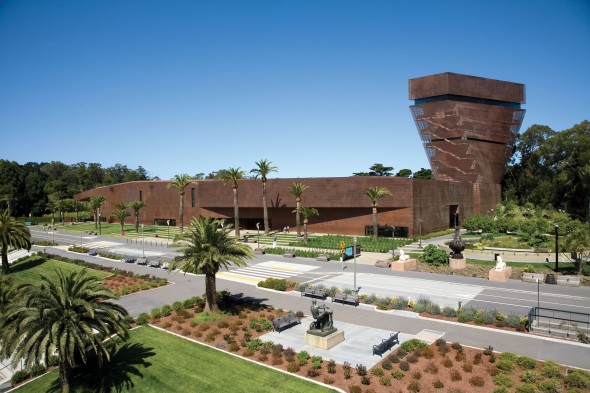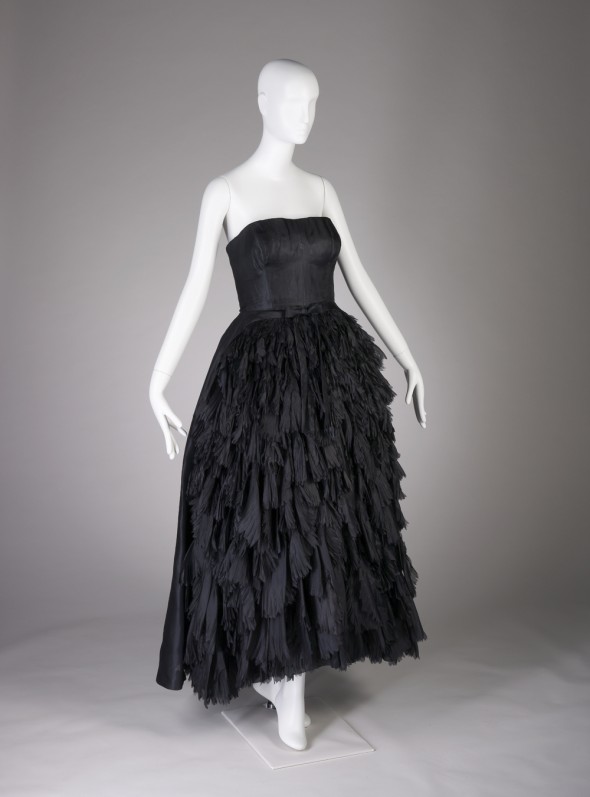
- Photography by Gregory Bertolini
Sheathed in dappled and perforated copper material, the de Young Museum poses in Golden Gate Park like a finely tailored fashion icon. The re-opening of the avant-garde building, which was designed by the Swiss team of Herzog & de Meuron, and local architects Fong & Chan, marked a new unification of fashion and the museum world. In the five years since it opened its door again, the de Young has become the preferred North American venue for world-class fashion exhibitions.
This is due in part to the architecture itself. Each gallery within the new de Young was specifically conceived to shape the public’s interaction with the art. In the 13,000 square-foot textile gallery, this translates to dim lighting that protects delicate fabrics and angled glass cases that let the museum-goer view the garment from several directions. Such emphasis on properly viewing the pieces was not the case at the de Young when it was destroyed in the 1989 earthquake; a single costume case then housed some 12,000 garments. Now the museum’s collection includes over 13,000 pieces that range from haute couture designed by powerhouses like Dior, Madame Grès or Chanel to traditional rugs that once belonged to Turkmens.
The museum’s turn towards a relationship with fashion resulted from the hiring of John Buchanan, who was the Director of the Fine Arts Museums of San Francisco and the Head Curator in 2006. According to Jill D’Alessandro, the curator of the Textiles Department, when Buchanan came on board the Vivienne Westwood exhibition had been penciled into the calendar by former museum head Harry S. Parker III. But it was Buchanan who inked the deal and entered into a relationship with the Victoria and Albert Museum in London. This move made the de Young the only venue in North America for the Westwood show, and Buchanan already had his eye on another designer: Yves Saint Laurent.
The announcement of a calendar laden with fashion exhibits brought controversy, D’Alessandro admits.
“We were nervous about doing all these fashion shows,” she says, “as if critics might think they were like low-hanging fruit for us, (and we were introducing) something facile and designed to bring in more visitors. But in the case of Vivienne Westwood, the show was about more than just fashion. Westwood is legendary, intrinsically linked to the punk rock movement, and a brilliant social commentator. We decided to do the show on the strength of her artistic career.”

- Cristobal Balenciaga Evening ensemble of black silk gazar and wool, 1951 – Photography by Joe McDonald/Fine Arts Museums of San Francisco
After the success of the Westwood exhibition, YSL was a foregone conclusion. In this exhibit, the team at de Young utilized all of their assets, from the insight of Pierre Bergé, and the access they had to his joint foundation with Yves Saint Laurent, to the participation of Diane Charbonneau, the curator of contemporary decorative arts at the Montreal Museum of Fine Arts. Expanding beyond what it had been in Paris, the YSL show incorporated videos and sketches alongside the dresses.
Next up was the Balenciaga exhibit, which had originally been conceived by Oscar de la Renta. Hamish Bowles, who had been invited as a curator by de la Renta, had participated in the YSL symposium at the de Young; fresh from the positive experience of the YSL show, he suggested the San Francisco museum as an additional venue. For the de Young Balenciaga exhibit, Bowles has been given free curatorial rein. His strong vision and long list of fashion contacts are opening up a world of possibilities for the upcoming exhibit, which emphasizes the relationship between Balenciaga and Spain, and will open on March 26. The exhibit will be roughly twice the scope of its previous incarnation in New York. While the de Young’s 50 Balenciagas were edited down to a mere five, they have been accompanied by pieces from outside collections, as well as from Bowles’ own impressive holdings, to produce a look at how different aspects of Spanish culture shaped Balenciaga’s designs. The sections will be splintered into six themes: Spanish Art, Regional Dress, the Spanish Court, Religious Life and Ceremony, the Bullfight and the Dance.
Jill D’Alessandro sees the curator’s job as forging a link between items in the museum’s permanent collection and the new pieces being brought in for display. She equates this to “playing a game.” For the recent exhibition “To Dye For: A World Saturated in Color,” which was born of fashion’s continuing obsession with tie-dye, garments on display ranged from a tie-dyed tunic from the Wari-Nasca culture of pre-Hispanic Peru to modern garments such as an evening gown from Rodarte’s 2009 collection or an ikat trench coat from Oscar de La Renta’s 2005 collection. For the YSL exhibition, the designer’s interest in foreign cultures and use of strong colors, unique textures and elaborate embroidery, along with his obvious art inspirations, made it child’s play for de Young curators to create links with items from their own collection. In the case of Vivienne Westwood, the designer’s love of dramatic shapes based on historical costume and use of traditional Anglo textiles such as tweed and tartan also made it easy to interweave pieces from the museum’s permanent collection. And one can imagine Jill D’Alessandro already brainstorming on how best to complement the museum’s upcoming Jean Paul Gaultier exhibition.
This constant creation of new connections, from exchanges of ideas between the museum’s curators and patrons to the de Young’s relationships with other institutions like the V&A, the Louvre, the Balenciaga foundation and FIT, result in a vibrancy at the de Young. Intelligent public programming and educational programs, as well as events such as Friday Nights at the de Young, have brought an exciting energy and a younger audience to the museum. Fashion and design schools now see the de Young as an invaluable resource. Across the United States, more and more museums are holding fashion exhibitions, but still, the de Young stands out for striving to shape new attitudes towards how we perceive fashion, both as an art form and as a historical and cultural mirror.
– Karena Akhavein

